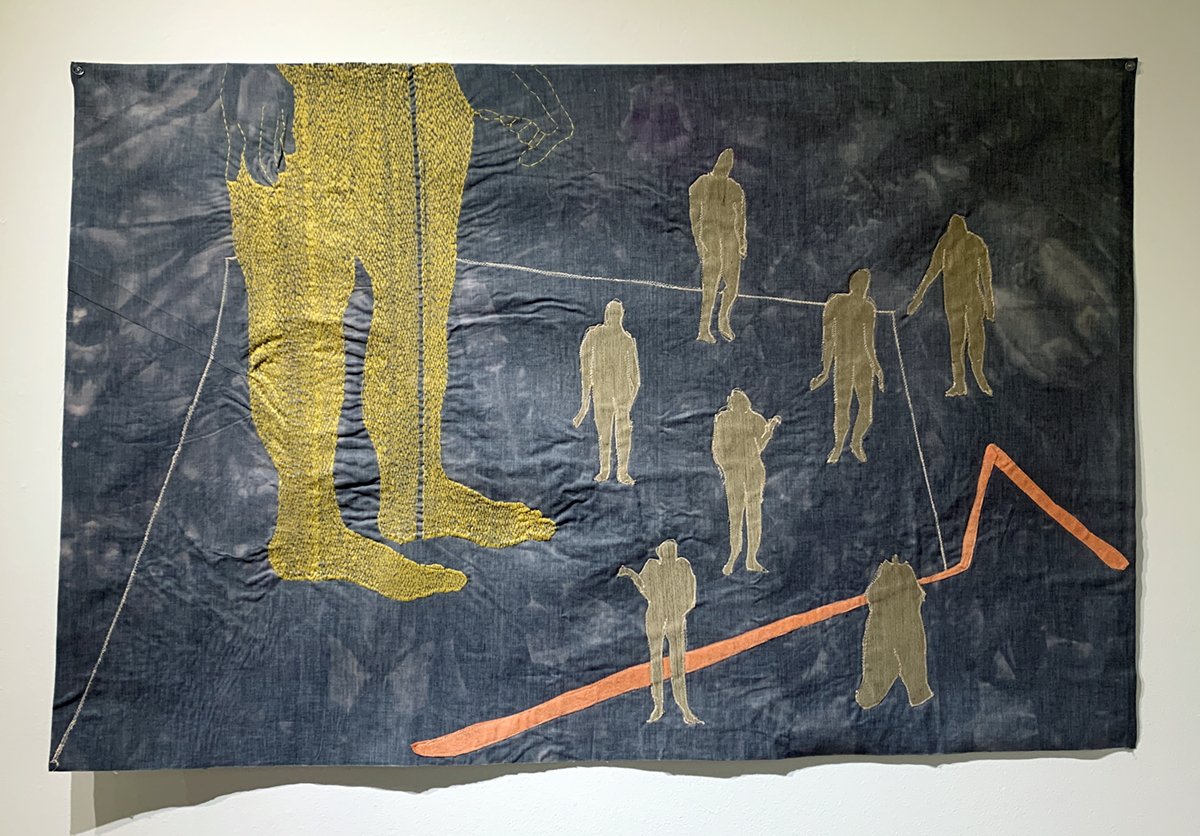Oddments
Elnaz Javani: Oddments
Mariani Gallery, Guggenheim Hall, University of Northern Colorado
1741 8th Avenue, Greeley, CO 80631
September 9–October 10, 2024
Admission: Free
Review by Parker Yamasaki
The same way a dancer works hard to appear soft, Elnaz Javani’s works in Oddments, on view at the Mariani Gallery until October 10, exude a quiet sense of power. On display are ten hanging pieces made over the past two years and a set of animal-like figures constructed in 2020.
Elnaz Javani, My Effigies, 2020, white muslin fabric and black thread. Image courtesy of the Mariani Gallery.
That fiber arts are traditionally viewed as feminine trades—a fact that reviewers and artists tend to rightfully reference—doesn’t seem especially relevant in Javani’s case. It was Javani’s father, a tailor by trade, who introduced the young artist to cloth and clothing. She recalls making objects throughout her childhood with whatever materials were available. After years of studying painting and graphic design throughout high school and college, Javani gradually reintroduced fabric into her artistic practice around 2010, trading paint and brush for needle and thread. [1]
An installation view of Elnaz Javani’s Oddments exhibition at the Mariani Gallery on the campus of the University of Northern Colorado in Greeley. Image courtesy of the Mariani Gallery.
That’s not to say the feminine history of art made with fabric is entirely irrelevant to her work either. She did eventually study the history of fiber art and its role in early feminist movements once she was working with the medium regularly. But her current work doesn’t seem as concerned with adding to or correcting that history. Javani’s choice of fabric, instead, feels more like a natural conduit for the themes she’s interested in, like movement, security, and the body.
Elnaz Javani, Coming Undone, 2023, hand-stitched embroidery, hand-dyed fabric, and appliquéd cotton. Image courtesy of the Mariani Gallery.
Fabric makes the clothes we shield our bodies with and the blankets we slip under at night. It’s an armor that guards us not despite its softness but because of it—it conforms to our bodies and wraps us tight, keeping us secure while we dance through the world.
And Javani’s figures do dance. Some shapes are so fluid it takes a moment to identify them as human figures.
Oh, that one is upside down, feet kicked into the air.
Oh, that one is arching back, nearly parallel to the ground.
Elnaz Javani, Midnight Sun, 2023, hand-stitched embroidery, hand-dyed fabric, appliquéd cotton, sublimation, and discharge printing (left); Slip Through, 2023, hand-stitched embroidery, hand-dyed fabric, appliquéd cotton, and sublimation printing (right). Image by Parker Yamasaki.
With the exception of a few obvious arms and a pair of large feet, the anatomies are much more ambiguous than in Javani’s past works. Her previous figures depict tension. The stitches are tight, the hands are clenched.
The fluidity found in this exhibition doesn’t depict a lessening of tension as much as it does a mature stance on ambiguity. What we see here are figures that don’t fit into neat categories any more than a complex human can.
Elnaz Javani, Temptation, 2022, hand-stitched embroidery, hand-dyed fabric, and appliquéd cotton. Image courtesy of the Mariani Gallery.
The body in Temptation, one of the largest works in the gallery, is deconstructed almost to obscurity, rescued only by a hand shape and a pair of pink legs. Temptation also has the strangest shape of any of the wall hangings—it’s the most clearly patched together. We see the stitching, the chunky cuts of fabric, and the cloth’s frayed edges more clearly than in the other panels, which are closer to rough rectangles.
Elnaz Javani, My Effigies (detail),2020, white muslin fabric and black thread. Image courtesy of the Mariani Gallery.
That’s one of the strengths of fiber arts, especially in connection to the body. There is space for a work to show its seams but also be considered whole and complete. What’s more human than feeling stitched into form, our edges frayed and cuts exposed, and going about our days anyway?
Elnaz Javani, Chasing the Blue Horizon, 2022, hand-stitched embroidery, hand-dyed fabric, and appliquéd cotton. Image by Parker Yamasaki.
Despite an overall tendency toward looseness, there are tight elements full of clarity throughout the gallery. Chasing the Blue Horizon, for instance, a hand-embroidered panel, has one of the densest patches of threadwork in the gallery. Tightly stitched yellow thread forms the lower half of a body from roughly hips to toes. At the yellow figure’s feet is a group of much smaller figures, their bodies positioned to suggest conversation, inquiry, or contemplation. It’s the same way bodies might be positioned at a lively gallery opening, angled to consider the new works on the wall—or a large, yellow human to the right.
An installation view of Elnaz Javani’s Oddments exhibition at the Mariani Gallery. Image courtesy of the Mariani Gallery.
That said, the feeling of the exhibition is one of movement, owing partly to Javani’s choice of medium.
Again, the fabric works hang, they aren’t mounted or framed. They cast irregular shadows depending on how they are wrinkled or blown. But it’s also an exhibition concerned with the limitations of movement—movement that is mandatory but not guaranteed, movement that takes work, time, and strength. Javani creates scenes where figures don’t just dance, they dance and endure.
Parker Yamasaki is a western states arts writer based in Lafayette, Colorado. She is a culture reporter for the statewide, nonprofit newsroom The Colorado Sun. She is also a freelance critic. Her work has been published in The Chicago Reader, Newcity Chicago, Austin Monthly, and various online publications.















